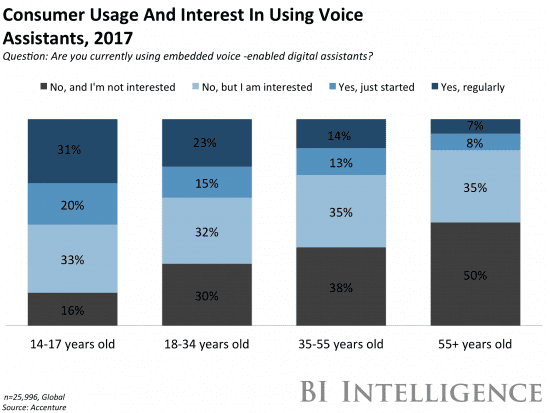Chart of the Day: Consumer Interest in Using Voice Assistants and Voice Search
Originating from the smartphone trend of voice search, where Apple and Google introduced voice assistants on their smartphone operating systems, we now have voice interactions through the likes of Apple Siri, Google Assistant and Amazon Alexa/Echo. This seems to be a growing trend across all the main digital platform providers and these voice assistants are predominately used for search queries.
Google highlighted that more than 20% of mobile queries are voice-based and this will only grow by 2020. 40% of millennials have already started making search queries through a voice assistant, prior to making a purchase. In fact, a research report from BI Intelligence shows that the younger you are, the more likely you are to switch to and prefer voice-activated search as opposed to traditional search engines.

The chart shows the stark differences in preference for using voice assiatnts against the age demographic, with 31% of 14-17 years old being definitively interested in voice search in comparison to only 7% of individuals that are 55+ years old, and 50% of them not being interested at all.
Research by Business Insider highlighters that, "advances in artificial intelligence (AI) are allowing [voice-search] to accurately understand more information, while upgrades to mobile networks are facilitating quick transfers of data to robust clouds, enabling fast response times", making voice-activated searches a more user-friendly experience.
Although there are still a number of critical barriers to overcome before this platform will see any form of mass adoption, due to both technological and societal hardships, trends such as these are vital to keep up with, if you want to successfully capture your online audience.
You could potentially miss out on a huge portion of your sales if your E-commerce business isn't keeping up with the latest technological advancements, such as conversational commerce, especially if your target audience falls within the Millennial or Gen Z categories.








